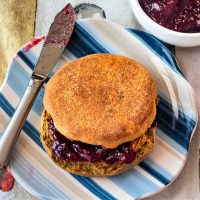
Spent Grain English Muffins
Spent grain English muffins are not hard to make, make excellent use of spent grains from brewing, and they freeze well so you can pop one in the toaster for an easy breakfast.
Servings 10 English Muffins
Calories 262kcal
Ingredients
For the Sponge
- 8 oz whole milk 1 cup
- 3 oz unsalted butter 6 Tablespoons
- 2 Tablespoons malt syrup
- 4 oz spent grain flour
- 4 oz bread flour
- 2 teaspoons instant yeast
For the Dough
- 8 oz bread flour
- 1 large egg
- 1 ½ teaspoons kosher salt I use Morton's. If weighing, you need 7 grams
For Shaping and Rising
- fine cornmeal or semolina about 1 cup
Instructions
To Make the Sponge
- Heat the milk to 180F. Scalding the milk will denature any whey proteins that could inhibit the rise. I generally don't find it necessary, but when working with a coarse flour such as spent grain flour, I like to hedge my bets.
- Once the milk is hot and steaming, remove from heat and stir in the butter so it melts.
- Stir in the malt syrup.
- Cool to no hotter than 120 F.
- Stir in the two flours.
- Once the flours are incorporated, stir in the yeast.
- Cover the bowl with plastic wrap and let hang out on the counter for 4 hours. The sponge will rise up and then collapse.
To Make the Muffins
- Add all the sponge to the bowl of your stand mixer.
- Add the additional bread flour, the egg, and the salt.
- Mix on low speed with the dough hook until all the flour is incorporated, about 2 minutes.
- Increase the speed to medium and knead for 8-10 minutes until you get a soft and stretchy dough.
- Gather the dough into a smooth ball and plop it back in the mixer bowl.
- Spray the top generously with pan spray or brush with some neutral oil.
- Cover the bowl and let rise until doubled. This should only take about 1 1/2 hours.
- Line a half sheet pan with parchment, spray lightly with pan spray, and then dust liberally with fine cornmeal or semolina.
- Once the dough is well-risen, scrape the dough out onto an oiled surface and press out all the gases.
- Divide dough into 10 equal pieces of about 3 oz each.
- Shape each piece of dough into a ball, round each ball between your palms and the counter to stretch the dough fairly taught across the top, then flatten each disc with your palm until each is about 1/2" thick.
- Place each proto English muffin onto your prepared pan and sprinkle each with a bit more cornmeal or semolina.
- Cover with plastic wrap and let rise until somewhat puffy, about 45 minutes.
- Place a large cast-iron skillet over medium-low heat. Place as many muffins as will fit in the pan (I could do 5 at a time) and put the rest of the tray in the fridge.
- Cook the muffins until browned on one side and the dough is feeling somewhat stiff around the sides. Keep rotating the muffins in the pan to promote even cooking.
- Turn the muffins when nicely golden brown on the bottoms and continue cooking, rotating each muffin in turn, until they are golden brown.
- These muffins are fairly thick, so to make sure they were completely baked through, I finished them off in my toaster oven for 5 minutes at 350F.
- Repeat the with second half of the muffins.
- TIMINGFor my first 5 muffins, it took 17 minutes on the first side, moderating the heat from medium-low to low, and about 12 minutes on the second side, plus the 5 minutes in the toaster oven. You want the internal temperature of the muffins to reach 195F-200F. The second batch in my now well-heated pan took 12 minutes on the first side, about 10 minutes on the second, and 5 minutes in the toaster oven.
- Remove the muffins to cool down completely.
- Split each muffin around its equator by sticking the tines of a fork into the muffin all the way around. Then pull each muffin apart.
- These English muffins really shine when toasted, bringing out all the malty notes in the spent grains.
- Serve with either sweet toppings (butter and jam) or use for the base of a breakfast sandwich.
Notes
To spread over two days, make the dough up until the point of the first rise. Refrigerate it overnight and proceed with shaping in the morning.
Storing
Allow the muffins to cool completely. Then freeze in a heavy-duty zip-top freezer bag, pressing out as much air as you can before sealing. Muffins will stay fresh-tasting for up to 3 months.Nutrition
Serving: 1g | Calories: 262kcal | Carbohydrates: 38.6g | Protein: 7.1g | Fat: 8.8g | Saturated Fat: 5g | Cholesterol: 39mg | Sodium: 531mg | Fiber: 3g | Sugar: 2.9g